Hungary
![]()
The title of this article is ambiguous. For the people of the same name, see Magyars.
Template:Infobox State/Maintenance/NAME-German
Hungary (Hungarian Magyarország [ˈmɒɟɒrorsaːɡ]![]() ) is a landlocked country in Central Europe with a population of around 9.8 million. Located in the Pannonian Basin and crossed by the Danube River, it borders Austria, Slovakia, Ukraine, Romania, Serbia, Croatia and Slovenia.
) is a landlocked country in Central Europe with a population of around 9.8 million. Located in the Pannonian Basin and crossed by the Danube River, it borders Austria, Slovakia, Ukraine, Romania, Serbia, Croatia and Slovenia.
The capital and largest city is Budapest, other major cities include Debrecen, Miskolc, Szeged, Pécs and Győr. The country has been a member of the United Nations since 1955, a member of NATO in 1999 and has been part of the European Union since 2004.
Population
Demographic structure
As in other Western industrialized nations, an aging of society is also evident in Hungary. For example, 15.9 percent of the population was under 15 years old, the majority of residents were 15 to 65 years old (68.6 percent), and 15.5 percent were over 65 years old. The combined fertility rate in 2018 was 1.6 children per woman (Germany: 1.6; Austria and Switzerland: 1.5; world: 2.4). Life expectancy in 2015 was 71.7 years for the male population and 78.9 years for the female population.
According to the 2001 census, Hungary still had just under 10.2 million inhabitants in that year, with an estimated population decline of 0.32 percent. The main cause is the low birth rate of around ten births per 1000 inhabitants. According to the figures of the Federal Statistical Office, the decline in the number of inhabitants that has been recorded since the 1980s is also continuing. According to the CIA's latest estimate, there were about 9.826 million people living in Hungary in 2018.
Ethnicities
→ Main article: Ethnic groups in Hungary
By far the largest ethnic group is the Magyars, who make up 92.3% of the population according to the 2001 census.
The largest of the ethnic minorities in Hungary are the Roma (see Roma in Hungary). According to a census, they are about 2% of the total population; according to other estimates, they are significantly more.
Important ethnic groups are Hungarian Germans (including Danube Swabians) (0.6 %), Slovaks (0.2 %) and Croats (0.15 %). According to these statistics, all other ethnic groups are represented by less than 10,000 persons. In terms of numbers, Romanians, Ukrainians, Serbs, Slovenians and Wends, Poles, Greeks, Bulgarians, Russians and Armenians follow. No other choices were available. Over 27,000 people indicated "Unknown." Over five percent of respondents did not answer the question.
Outside Hungary, about 2.4 million Magyars live in the Carpathian Basin. Due to the Treaty of Trianon as a result of the First World War, their settlement areas lie beyond today's national borders. This still occasionally leads to political disagreements between the neighbouring countries and Hungary.
In 2017, 5.2% of the population was born abroad. The most common countries of origin were Romania (210,000 people), Ukraine (50,000) and Serbia (40,000). Large Hungarian minorities live in all three countries.
Religions and denominations
The 2011 census also asked about religious denomination. 39 percent of the population professed the Roman Catholic and the Hungarian Greek Catholic Church. 11.6 percent of the population were Calvinists, 2.2 percent Lutherans. Before the Holocaust, there were about 800,000 Jews living in Hungary. Of the Jews living in Hungary today, just under 11,000 professed the Jewish faith in the last census. 18.2 percent of the population said they were nondenominational or atheists. 27.2 percent did not specify. There is no church membership in the strict sense in Hungary. There is no church tax. However, there is a possibility to allocate one percent of the income tax to a religious community. In 2008, half a million taxpayers made use of this option in favour of the Catholic Church. This is followed by the Reformed with 160,000 and the Lutherans with 50,000 taxpayers. In fourth place is the Krishna movement (11,000), followed in fifth place by the Jewish communities (5,000).
All figures below refer to the previous 2002 census.
Religious affiliation according to 2001 census:
- Christians and Christian-oriented: 7,584,175 (74.37 %)
- Catholics: 5,558,961 (54.51 %)
§ Roman Catholics: 5,289,521 (51.87%)
§ Greek Catholics: 268,935 (2.64%)
§ Other Catholics: 505 (< 0.01 %)
- Evangelical Reformed (Calvinists and members of the Reformed Church in Hungary): 1,622,796 (15.91%)
- Evangelical Lutheran: 304,705 (2.99%)
- Jehovah's Witnesses: 21,688 (0.21%)
- Baptists: 17,705 (0.17 %)
- Orthodox and Oriental Christians: 15,298 (0.15%)
§ Romanian Orthodox: 5,598 (0.05%)
§ Russian Orthodox: 3,502 (0.03%)
§ Other Orthodox and Oriental: 6,198 (0.06%)
- Pentecostals: 8,428 (0.08 %)
- Unitarian: 6,541 (0.06 %)
- Adventists: 5,840 (0.06%)
- other Christians and Christian-oriented: 22,213 (0.22 %)
- Jews: 12,871 (0.13 %)
- Buddhists: 5,223 (0.05 %)
- Muslims: 3,201 (0.03 %)
- other: 5,143 (0.05 %)
- without religious affiliation: 1,483,369 (14.55 %)
- no information or unknown: 1,104,333 (10.83 %)
Language
→ Main article: Hungarian language
The language in use in Hungary is Hungarian. It belongs to the Finno-Ugric branch of the Uralic languages, to which most non-Indo-European languages spoken in Central Europe belong. The dialects of Hungarian differ less from each other than, for example, the German dialects. Throughout the Hungarian-speaking world, nine major dialect groups are distinguished. From the period of Habsburg rule (1699 to 1867 and 1918) in Hungary comes the influence of the German language. In addition to Hungarian, the languages of the minorities are widespread, see the article Ethnic groups in Hungary.
Education
School system
In the first half of the 20th century, the Hungarian school system still had many similarities with the educational system in Austria, and after the Second World War it adopted some elements of the Soviet school system. Thus, a system with twelve grades was created, which, in contrast to the Soviet comprehensive school system, was divided into an eight-year primary school and a three- or four-year secondary school, and the grading system from 1 to 5 was introduced, in which the one is the worst grade and the five is the best grade. This grading system is still in use today.
All children were required to attend Russian classes starting in 5th grade. Many language teachers were retrained as Russian teachers in the 1950s. After the fall of communism in 1989, Russian was removed from the curriculum as a compulsory subject and other languages could be chosen instead, which again led to retraining programmes; this time Russian teachers had to retrain as German or English teachers.
The school system has been liberalized: Currently, there are more and more six- and eight-year grammar schools in addition to the four-year ones. The "Oberstufe" (grades 5-8) of the eight-year primary school is becoming more and more similar to the Hauptschulen and Realschulen in German-speaking countries. In addition to the gymnasiums, there are "Fachmittelschulen" (szakközépiskola), in which a profession can be learned in addition to obtaining a university entrance qualification. This form of education is often supplemented by an additional year in which the specialist knowledge is deepened; these institutions are called technical colleges. There are also vocational schools without a higher education entrance qualification, which can be attended if you are doing an apprenticeship. The number of bilingual secondary schools is constantly growing. It is interesting to note that in Hungary, which is otherwise very Budapest-centered, there are many bilingual high schools in the countryside. There are also schools for minorities, one example being the Gandhi Grammar School in Pécs, which offers talented Roma children the opportunity to take the school-leaving exam.
The examinations for obtaining the university entrance qualification are held uniformly and centrally throughout the country. Since 2005 it has been possible to take a kind of "Leistungsmatura" in some subjects, which at the same time counts as an entrance examination for university. The acquisition of the higher education entrance qualification enables studies at universities and universities of applied sciences. For many fields of study, there are entrance restrictions, there are entrance examinations, and also the performance in secondary school or the language skills can be decisive for admission. However, there are also fields of study that can be taken without an entrance examination if the considerable costs are borne by the student.
Customs at the maturity exam
There are many traditions in Hungarian secondary schools, most of which are connected with graduation and the school-leaving examination. A few months before the exam, the graduating classes, dressed in festive attire (the boys usually wear a suit, the girls a sailor dress), have their pictures taken individually and arrange them on a wooden board together with the teachers' photos. These boards (the érettségi tablók, "maturity boards") are displayed in various shop windows until the Matura. Around February the Matura balls take place, which are called szalagavató bál ("ribbon consecration") because the Matura candidates get a ribbon with the years between which they attended school pinned on their jackets. The ribbon must be worn until the exam, otherwise, it is said, one fails. On the last day of school for the graduating classes (before the written exams), the ballagás festival takes place: a graduation party in which the students march in a polonaise through the school building. They sing old student songs, such as Gaudeamus igitur, or melancholy folk songs about saying goodbye. They receive flowers from their families and friends. That same evening, the graduating classes visit their favorite teachers at home and serenade them under the window (szerenád). Most teachers then invite them for a snack. However, the written Matura exams are centralised in Hungary, which means that every student gets exactly the same tasks at the same time, which are announced via the internet and radio. However, there have been several Matura scandals in recent years because the tasks were made public before the exams.
University
The most famous university in Hungary is the Eötvös Loránd University, which has a Faculty of Philosophy and a Faculty of Law, as well as a Faculty of Education. Medical education in Hungary enjoys a very good international reputation. Semmelweis University is known worldwide as a university of human medicine. Like the universities of Pécs and Szeged, it offers medical education in Hungarian, German and English. Furthermore, the Andrássy University in Budapest exists since 2001 as the only completely German-speaking university outside the German-speaking area in Central Europe. The number of private and denominational universities is constantly growing. Private universities charge high tuition fees. Even a second degree or PhD program at a public university or college must be partially financed by the students.
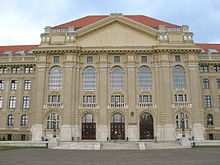
University of Debrecen
.jpg)
Budapest University of Technology and Economics
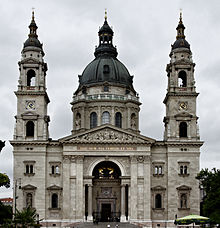
St Stephen's Basilica

Hungary birth rate by region (2014) 1.7 – 1.9 1.5 – 1.7 1.4 – 1.5 1.3 – 1.4 < 1.3

The regional distribution of denominations according to the 2001 census: Largest religious community Roman Catholic Church in Hungary Greek Catholic Lutheran Reformed Other religions Confes-sionless < 50 % 50–66,6 % > 66,6 %

Hungarian woman in traditional costume.
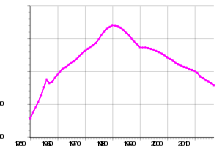
Development of the population in thousands since 1950
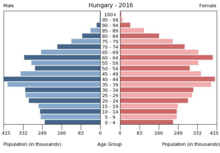
Population pyramid Hungary 2016: Hungary has an ageing population
History
→ Main article: History of Hungary
9th to 15th century
The Magyars, led by the Grand Duke Árpád, migrated into the Carpathian Basin at the end of the 9th century, allegedly in 896, and conducted raids throughout Europe. These were successfully continued by Árpád's successors until 955, when Otto I was able to repel the Hungarian attacks with a crushing victory on the Lechfeld. The Kingdom of Hungary was founded on August 20, 1000 by Stephen I, who shaped the country according to the Carolingian model against the bitter resistance of the old nobility (founding of the county system that still exists today).
In the "Mongol Storm", as the attacks of the Golden Horde of the Mongols under the army leader Batu Khan in the years 1241 and 1242 are called, the country was devastated and depopulated in large parts; 50% of the population of Hungary died. King Béla IV called settlers from the Holy Roman Empire (Swabia) into the country for the new settlement, who subsequently became partly Magyarized.
In 1301 Andrew III, the last ruler of the House of Árpád, died. In 1370-1386 and 1440-1444 Hungary was ruled by the Angevins and Jagiellons in personal union with Poland.
Subsequently, Hungary had only one Hungarian king, Matthias Corvinus, who ruled the country from 1458 to 1490. Under the highly educated Matthias, Hungary rose to become a major political power and a center of Renaissance culture and humanism. As a Renaissance prince, he attracted scholars and artists from Italy to his court, founded the university in Pressburg (Pozsony, today Bratislava) and the Corvina library in Ofen (Budapest); his great empire disintegrated after his death.
Between 1490 and 1526 the Polish-Lithuanian Jagiellons ruled Hungary and Bohemia in personal union.
16th to 19th century
The end of Hungary's independence came around the middle of the 16th century with the conquests by the Ottoman Empire. On August 29, 1526, Sultan Suleyman I defeated King Louis II of Bohemia and Hungary at Mohács (where a memorial has been located since 1976), who drowned while fleeing. Most of Hungary came under Turkish rule, with the unconquered parts either coming under Habsburg rule in continuity with the Hungarian kingship as Royal Hungary (including western Upper Hungary) or being separated from Hungary and placed under Ottoman suzerainty as the Principality of Transylvania.
After 145 years of Turkish occupation of Hungary, Buda fell after the second siege in 1686, and the Habsburgs now conquered all of Hungary. The Hungarians, however, disapproved of their harsh rule, so that from 1703 to 1711 there was a Kuruc rebellion under Prince Franz II Rákóczi, a nobleman from Transylvania. Since the tensions between the Hungarian nobility and the Viennese court could not be eliminated, they erupted (after apparently amicable negotiations and concessions by the emperor to the Hungarians) in the revolution of 1848/49, which was bloodily put down with the help of Russia (invoking the "Holy Alliance"), permanently worsening the climate in the monarchy.
After continuing unrest in the country, the Austro-Hungarian Compromise of 1867 made Hungary an equal part of the dual monarchy of Austria-Hungary. Franz Joseph I now called himself Apostolic King of Hungary (he now had himself crowned in Buda) and Emperor of Austria (until then the Hungarian royal title had been subordinate to the imperial title). This personal union, established de jure by the Pragmatic Sanction, became a real union through identical Austrian and Hungarian basic laws concerning foreign policy and the army as well as their financing. A voluntary customs and trade union followed, the guilder and later the crown currency remained common (Austro-Hungarian Bank). Ferenc Deák and Count Gyula Andrássy played a leading role in the success of the settlement for the Hungarian side. The Hungarian "half of the empire" (as they liked to say in imperial Austria; Hungary did not want the term empire for the Dual Monarchy) included the lands of the Kingdom of Croatia and Slavonia (essentially the present-day state of Croatia without Dalmatia), Vojvodina, a large part of Romania (Transylvania in the broader sense and the now Romanian part of Banat), and small parts of Poland and Ukraine (Carpathian Ukraine). Subsequently, there was a significant economic boom in the country and especially in its capital, which was expressed not least in the millennium celebrations of the Magyar land seizure and the Budapest Millennium Exhibition in 1896.
However, the multi-ethnic state of the Kingdom of Hungary was characterized by internal tensions (aspirations for independence of the non-Magyar peoples, nationality conflicts in the course of the Magyarization policy). Although the leading role in industrialization was often played by representatives of minorities (German Austrians and Jews), who tended towards voluntary Magyarization, this did not apply to the Slavic and Romanian populations of the Hungarian half of the empire. This favoured the break-up of the heterogeneous state structure after the lost First World War. The decisions of the victorious powers resulted in Hungarian minorities living in Czechoslovakia (now Slovakia), Romania and the Kingdom of Serbs, Croats and Slovenes (now mainly Serbia) as a result of the Treaty of Trianon. However, Slovak, Romanian and German minorities also remained in Hungary.
From 1918 to 1945
On October 31, 1918, Hungary declared its withdrawal from the Real Union with Austria and recalled the Magyar troops from the Italian front. With that the k. u. k. Monarchy was dissolved. In response to urgent demands from top Hungarian politicians, King Charles IV declared on 13 November 1918 at Eckartsau Palace (Lower Austria) his renunciation of any share in the affairs of state in Hungary, just as he had declared for Austria as Emperor Charles I two days earlier. However, a formal abdication did not take place.
Prime Minister Mihály Károlyi proclaimed the democratic Republic of Hungary on 16 November 1918, and in January 1919 he was elected the country's first president. However, the social grievances resulting from the lost war continued. After the peaceful civil revolution of 1918, the government of the new republic enacted People's Law Number 1, which for the first time in Hungarian history guaranteed equal voting rights for both sexes, exercised through party lists. However, no elections were held on this basis. The conservative wing of the nationalist movement overthrew Prime Minister Mihály Károlyi in a counter-revolution, and women's suffrage was again abolished.
After Károly's resignation on 21 March 1919, the Communists, led by Béla Kun, took power and established a soviet republic. The post-revolutionary electoral law of November 1919, contained in the government decree 5985/1919/ME, then guaranteed again a gradually extended right to vote. Nevertheless, the 1920 elections were rocked by intimidation and corruption. Women and men over 24 had the right to vote if they had been Hungarian citizens for six years and had already resided in Hungary for at least six months. Women's right to vote was limited to those who could read and write. Men were exempt from the age restriction if they had served at least twelve weeks of military service at the front. A serious setback followed in 1922: a suffrage reform raised the voting age for women to 30. A certain level of schooling also became a requirement: four years of primary school for men and six for women (four if they had at least three children or were their own income and heads of household).
In order to regain the territories lost after the First World War (Transylvania, Slovakia), Hungary took military action against its neighbouring countries. In the Hungarian-Romanian War, however, the Hungarian "Red Army" quickly found itself on the defensive. With the occupation of large parts of the country by Romanian troops, the socialist republic collapsed on August 1, 1919, and Béla Kun was forced to flee. After the end of the soviet republic, Archduke Joseph August of Austria, from 7 August to 23 August Reichsverweser, failed in his attempt to form a government because of the negative attitude of the Allies. In the end, the former imperial and royal admiral Miklós H. H. Admiral Miklós Horthy, who had previously formed a conservative counter-government to the Communists in Szeged, entered Budapest with his troops on 16 November 1919.
Elected by the National Assembly as imperial administrator, Horthy formally reinstated the monarchy on March 1, 1920, but subsequently remained de facto head of state. Charles IV attempted twice to resume rule in Hungary from his exile in Switzerland; both times, however, Horthy refused to hand over power. The restoration of the Habsburg monarchy was forbidden to Hungary in the course of the peace negotiations (Paris Suburb Treaties) (Treaty of Trianon). On November 6, 1921, the Reichstag passed the so-called Dethronement Act, formally deposing the Habsburg-Lorraine dynasty. The government then recognized the Trianon Peace Treaty, under the terms of which Hungary had to cede two-thirds of its territory to Czechoslovakia, Romania, the South Slav state, and Austria. Most of the territories now ceded had already separated from Hungary in 1918/1919 and had joined the new successor states of the Danube Monarchy or been taken possession of by them; the later Burgenland, however, did not become part of Austria until the autumn of 1921.
→ Main article: Hungary in the Second World War
From 1933 onwards, under Prime Minister Gyula Gömbös, Hungary moved politically closer and closer to Nazi Germany due to economic crises and revisionist propaganda. In the Vienna Arbitration Awards dictated by Nazi Germany, Hungary received back Hungarian-inhabited southern Slovakia (along the Danube) in 1938 and a considerable part of Transylvania (from Romania) in 1940. The Balkan campaign (1941) also gave Prekmurje to Hungary. However, each of these territories had to be abandoned again in 1945.
In return, Horthy entered the war against the Soviet Union on the side of the Axis powers on 27 June 1941, but suffered heavy losses due to insufficient equipment. Contact was made with the Western Allies, but they referred to Moscow. When these contacts became known to the Germans, they occupied the country from mid-March 1944 and set up a collaboration government under Döme Sztójay, who immediately began deporting the Jewish population. Over 200,000 of the Jewish Hungarians living on the territory of the state in 1937 perished in concentration and extermination camps. Another 200,000-plus victims came from the territories Hungary occupied under the Vienna Arbitration Awards. After Romania surrendered, Horthy decided to send a delegation with an offer of surrender to Moscow on September 28, 1944, and negotiations led to the radio proclamation of the armistice on October 15. After Horthy's arrest in the autumn of 1944, war participation continued under the fascist Arrow Cross movement of Ferenc Szálasi. For Hungary, the fighting of the Second World War ended with the battle for Hungary and the occupation of the country by the RedArmy, which was completed by 4 April 1945.
Eastern Bloc, Hungarian Uprising and the Fall of the Wall
Hungary came under Soviet influence due to the Yalta Treaty. In 1945, unrestricted suffrage was restored. In the free parliamentary elections in November 1945, the Smallholders' Party won 57% of the vote, with the Communists in third place, just behind the Social Democrats, with 17%. Under Soviet pressure, the Communists were nevertheless admitted to the government and gradually seized power until 1949, subjugating the country to Soviet-style communism. In 1948 the Hungarian Social Democratic Party was forcibly united with the Communists to form the Party of Hungarian Labourers (MDP), which was replaced by the Hungarian Socialist Workers' Party (MSZMP) in 1956. On August 20, 1949, a constitution based on the Soviet model was adopted. Until 1953, Hungary pursued a Stalinist course under Mátyás Rákosi.
On 23 October 1956 there was a popular uprising, during which Imre Nagy, who had already been Prime Minister from 1953 to 1955, regained this office. He formed a multi-party government and called for parliamentary democracy and Hungarian neutrality. However, the uprising was bloodily put down by the Soviet army. Many Hungarians then left the country and emigrated to Western Europe or North America. Nagy was executed (his ashes were not ceremonially interred in Hungary until 1989). János Kádár, until then deputy prime minister, became general secretary of the Hungarian Socialist Workers' Party as well as prime minister. The initial repression of those involved in the uprising was followed by amnesties in the years between 1959 and 1963, which led to releases. In 1968 Hungary participated in the military intervention of the Warsaw Pact states in Czechoslovakia, which had become dangerously liberal for the Eastern Bloc.
Beginning in the 1960s, Kádár, who was General Secretary of the Hungarian Socialist Workers' Party until 1988 and also Prime Minister from 1956 to 1958 and from 1961 to 1968, allowed certain liberalizations in the political, economic, and cultural spheres that became known as "goulash communism." In 1987/1988 opposition groups were formed that promoted the peaceful change of system and questioned the legitimacy of Soviet (de facto Russian) domination (mention should be made of Imre Pozsgay, who in the office of minister of state publicly contradicted the doctrine of the "counterrevolution of 1956").
In 1988, under the pressure of circumstances, the now already elderly Kádár resigned at a special congress of the state party USAP, and was succeeded by Károly Grósz. There were also opposition voices in the communist USAP demanding free elections and the withdrawal of Soviet troops. This initiated the opening of the border to Austria, the dismantling of the border fortifications and thus the cutting of the Iron Curtain. As early as 2 May 1989, Hungarian border guards began dismantling the border fence. On 27 June 1989, Gyula Horn, the Hungarian Foreign Minister, together with his Austrian counterpart Alois Mock, cut the barbed wire at the border between Austria (Klingenbach) and Hungary (Sopron) in a symbolic action. Until August 1989, Hungary always extradited captured fugitives to the GDR. From 11 September 1989 Hungary also officially allowed GDR citizens to leave the country for Austria.
Hungary played a decisive role in the revolutions of 1989 in the former Eastern bloc countries and thus also in the peaceful revolution in the GDR, which paved the way for the reunification of Germany.
See also: List of Rulers of Hungary and List of Heads of State of Hungary
History since 1989
After 1989/90 Hungary became (politically speaking) part of the Western state system. After the fall of the Iron Curtain in 1989/90, the Hungarian state system was also renewed. On 23 October 1989 - the anniversary of the 1956 Hungarian National Uprising - the Republic of Hungary was proclaimed, and a modified version of the 1949 socialist constitution came into force. The model for this modified version was, among others, the German Basic Law. The government is responsible to the parliament, and the prime minister is responsible for the government's activities. In order to ensure the greatest possible stability of the government, the institution of a constructivevote of no confidence was created. Hungary's first free parliamentary elections since 1947 took place in March 1990.
The Hungarian Parliament is unicameral. It elects the President of the Republic, the Prime Minister, the members of the Constitutional Court, the Ombudsman of Minorities, the President of the Supreme Court and the Prosecutor General. The power of the President, elected for a five-year term, is limited.
Hungarian politics has been characterized by frequent changes of majority since the introduction of free and secret elections until 2010.
After the 1990 election, a conservative coalition government consisting of the MDF, FKgP and KDNP ruled until 1994. The prime minister was initially József Antall, and after his death in December 1993, Péter Boross. The governing coalition suffered a heavy defeat in the May 1994 election, while the Socialists (MSzP), who had emerged from the former Communist Unity Party, won an absolute majority of seats with 33% of the vote due to the electoral system. The new prime minister was Gyula Horn, who formed a coalition with the left-wing liberals (SzDSz) despite his party's absolute majority. The 1998 election brought another change of power. Fidesz, until then a small party, became the strongest parliamentary group. Viktor Orbán became prime minister for the first time. He presided over a coalition of Fidesz, MDP and the FKgP, which disintegrated during the election period, until its surprisingly narrow defeat in 2002.
In March 1999, Hungary became a member of NATO after its parliament voted overwhelmingly in favour of accession on 9 February. The country thus became one of the first countries of the former Eastern bloc to join the alliance.
After the 2002 elections, the MSzP again took over government responsibility together with the SzDSz. The new Prime Minister, Ferenc Gyurcsány, who had been in office since 29 September 2004, succeeded Péter Medgyessy, who had resigned after attempts to restructure the government.
On 1 May 2004, Hungary joined the European Union after a referendum resulted in an approval rate of 83.8%.
The government of MSzP and SzDSz was re-elected in the parliamentary elections of 9 and 23 April 2006. This was the first time that a government managed to remain in office.
In September 2006, details became public about a speech Gyurcsány had given to his parliamentary group after the parliamentary elections in April. In this speech Gyurcsány spoke of how the government had only lied in recent years in order to conceal the true state of the state's finances. With this speech Gyurcsány wanted to get his party to go along with the consolidation measures he had planned (VAT increase, practice fee, layoffs in the public service). In September and October 2006 there were repeated violent riots, especially in Budapest, which also overshadowed the celebrations of the 50th anniversary of the 1956popular uprising. Gyurcsány offered his resignation on 21 March 2009. A minority government of socialists and non-party professionals was subsequently formed in April 2019 under the non-party former economy minister Gordon Bajnai, tolerated by the SzDSz.
In the 2010 parliamentary elections, the electoral alliance of Fidesz and KDNP won 263 of the 386 mandates and thus had the two-thirds majority necessary for constitutional changes. On 29 May 2010, the new parliament elected Viktor Orbán as the new prime minister. On 18 April 2011, with the votes of the ruling parties, the new constitution, which came into force on 1 January 2012, was adopted, the Fundamental Law of Hungary. As the foundations of the nation, the Basic Law professes in its preamble, among other things, God, Crown (St. Stephen's Crown) and Fatherland, Christianity, family and national pride. The official name of the state was changed from Republic of Hungary (Magyar Köztársaság) to Hungary (Magyarország). However, Article B of the Constitution continues to refer to Hungary's form of government as a republic, and the form of government is parliamentary.
János Áder has been president since 2012.
In both the 2014 and 2018 parliamentary elections, Fidesz narrowly won a two-thirds majority in an alliance with the KDNP under amended electoral law.
The country became a stopover point for a large movement of refugees and migrants during the refugee crisis in Europe from 2015 onwards. Coming from Greece, they tried to reach Western Europe along various routes known as the Balkan route. The government erected a border fence on the country's southern borders and tightened its migration and refugee policy.
Hungary has been an observer in the Turkic Council since 2018.
_8.jpg)
Gödöllő Castle - as the official venue of the EU Presidency (2011)
.jpg)
János Kádár, communist head of state 1956-1988.
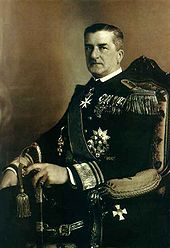
Miklós Horthy, Regent of Hungary 1920-1944.
.png)
Original homeland of the Hungarian people (Magyars)
.jpg)
Statue of King Stephen I at the Fishermen's Bastion in Budapest
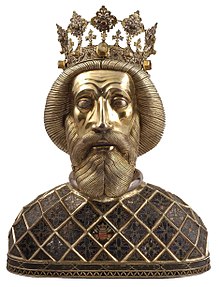
Ladislaus I
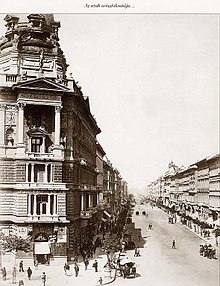
Today's Andrássy Street in Budapest, 1875
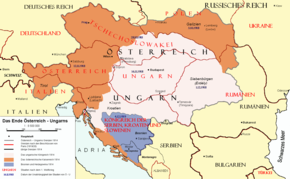
Map of the territorial division after the Treaty of Trianon (red lines) in comparison with the previous national territory (grey lines and coloured areas)
Questions and Answers
Q: What is the capital of Hungary?
A: The capital city of Hungary is Budapest.
Q: How many people live in Hungary?
A: Approximately 10 million people live in Hungary.
Q: What countries border Hungary?
A: The countries that border Hungary are Slovakia, Ukraine, Romania, Serbia, Croatia and Slovenia.
Q: What language is spoken in Hungary?
A: The official language of Hungary is the Hungarian language.
Q: When did Hungary become a member of the European Union (EU)?
A: Hungary became a member of the European Union (EU) in 2004.
Q: What does Magyarország mean?
A: Magyarország translates to "Hungarian country" or "Hungarian Republic".
Q: Who were the Magyar tribes?
A: The Magyar tribes were nomadic peoples who arrived to present-day Hungary during the late 9th century.
Search within the encyclopedia